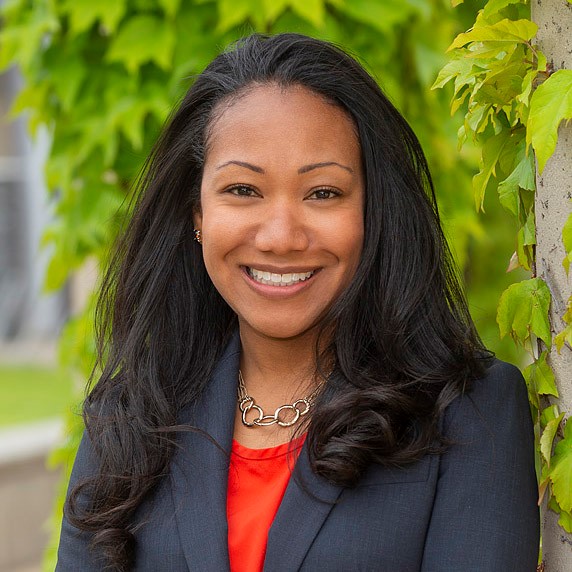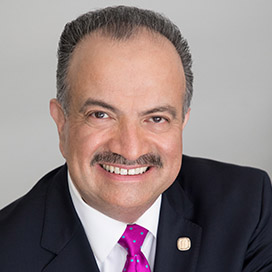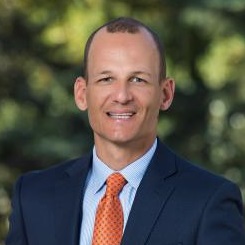The week, Gov. Gavin Newsom built on last year’s record state budget with a 2022-23 spending plan that tops it. Schools from transitional kindergarten to high school and community colleges would receive $102 billion plus $16 billion in a windfall surplus from this year. Higher education — the University of California, the California State University and the California Student Aid Commission — would get about $27 billion, with more ongoing but fewer one-time dollars than this year.
Within those big numbers are programs, priorities and new commitments that will be shaped by the public’s response and debated through June in the Legislature. EdSource has asked observers, advocates, students and legislators to initiate the discussion with their first take on the governor’s budget for 2022-23.
Scroll down and click on the photos to read their thoughts. Also, see reactions to the governor’s early education and K-12 education budget plans.

Sbeydeh Viveros-Walton
Public Advocates
What among the governor’s proposals will most advance students’ recovery from the pandemic and why?
Addressing the total cost of college, especially issues that are voiced by students as their priorities: optimizing the time students spend at community colleges to ensure that they complete their degrees and transfer as soon as possible, the rising cost of housing for community college students, exorbitant textbook costs and investing in existing equity initiatives across the three public segments.
What priority should have been in the budget but wasn’t?
We were disappointed not to see a more aggressive investment in Cal Grant reform in the governor’s proposed budget. We will continue to work with students and the administration to ensure that full implementation of the Cal Grant equity framework remains a priority as we move toward an adopted budget in June. Reforming the state’s grant aid program outright will ensure that more low-income students have access to California’s state aid program and participate in California’s economy.
Sbeydeh Viveros-Walton is the director of higher education at Public Advocates, a nonprofit law firm and advocacy organization that challenges the systemic causes of poverty and racial discrimination.

Keith Curry
President, Compton College and Compton Community College District
What among the governor’s proposals will most advance students’ recovery from the pandemic and why?
I was impressed with the governor’s funding proposal for California community colleges. The governor’s proposal to extend the revenue protections in a modified form to avoid fiscal declines in future years is necessary. It is genuinely appreciated, as community colleges can focus on our recovery and our students’ success. Also, the additional funding for our outreach and retention efforts will provide colleges with much-needed support to recruit prospective students and implement retention strategies for our current students. Finally, the governor’s proposal provides deferred maintenance funding to address the facilities needs at our colleges.
What priority should have been in the budget but wasn’t?
Although I am pleased with the governor’s proposal overall, including the funding to expand African American Male Education Network and Development student charters, the state should also provide specific funding to address the success of Black and males of color students in our community colleges. As you examine the enrollment, success and retention of Black and males of color students and the significant impact the pandemic has had on Black and males of color, the state of California must provide additional funding to prioritize other intervention and support programs supporting their success. Also, it is time for the state to focus on the structural inequities in state funding at community colleges in comparison to the California State University and University of California systems. This is especially true when you consider the number of low-income, African American and Latino students who attend California community colleges compared to the California State University and University of California systems.
Keith Curry is the president/CEO of Compton College and Compton Community College District.

Eric Premack
Charter Schools Development Center
What among the governor’s proposals will most advance students’ recovery from the pandemic and why?
The governor’s proposals for increasing student financial aid (e.g., expanded funding for the Middle Class Scholarship) and reducing needlessly high textbook costs reflect changes that will actually help students.
What priority should have been in the budget but wasn’t?
Cal Grant funding for private colleges, especially those with strong track records for graduating traditionally underrepresented students at high rates and on time, should be dramatically boosted to reflect funding parity with public colleges. The governor should propose dramatically reducing funding for both public and private colleges that have abysmal track records for leaving students deeply in debt with no degree.
Eric Premack is executive director of Charter Schools Development Center, a charter school support and advocacy organization based in Sacramento.

Lizette Navarette
California Community Colleges Chancellor's Office
What among the governor’s proposals will most advance students’ recovery from the pandemic and why?
The Vision for Success is alive and embodied in the governor’s budget proposal. Proposed investments across several areas will assist with the recovery. Notably, expanded access to state financial aid will help students whose lives have been disrupted by Covid. With many current and potential community college students citing the necessity to work full-time as a primary barrier to success in higher education, California needs to do more to address the true cost of college attendance. The budget also includes $150 million in one-time funds for student retention and enrollment efforts. This is aimed at continuing community college efforts and high-touch strategies to engage with former students who have withdrawn due to the impacts of the pandemic.
What priority should have been in the budget but wasn’t?
The need for expanded mental health services for students cannot be overstated, and it is something the Chancellor’s Office leadership has seen firsthand in our visits to colleges in the past few months. We will work with student leaders to advocate for the inclusion of additional mental health resources needed to help students achieve their educational goals.
Lizette Navarette is the executive vice chancellor of institutional supports and success at California Community Colleges.

Esmeralda Quintero-Cubillan
University of California Student Association
What among the governor’s proposals will most advance students’ recovery from the pandemic and why?
We are very excited to see the state of California reinvest in all three sectors of higher education. This new support, aimed at the principles of equity, access and affordability the governor put forward, will help ensure that the marginalized students who were disproportionately impacted by the pandemic are able to thrive at the University of California. We’re also looking forward to working with the university to find the best ways to invest this funding toward promoting diverse admissions and securing support for vulnerable student communities.
What priority should have been in the budget but wasn’t?
The principles underlying the governor’s proposed funding increase to the UC hold the possibility for impactful change. The commitment to creating debt-free pathways to a degree is especially necessary. However, the student association maintains that the most critical way to do this is by expanding and modernizing the Cal Grant system. Low-income students face some of the highest levels of debt, and achieving true affordability requires expanding the resources available to them.
Esmeralda Quintero-Cubillan is the president of UC Student Association and a senior at the University of California, Santa Barbara.

Joseph I. Castro
Chancellor, California State University
What among the governor’s proposals will most advance students’ recovery from the pandemic and why?
The increase to our general fund allocation will allow the CSU to both welcome additional new students and continue to bolster many of our student success initiatives in the upcoming year and in future years under the proposed five-year compact. That funding will support universitywide initiatives to increase graduation rates, identify new ways or scale existing programs to eliminate equity gaps, and to broaden access to the CSU for more California residents.
What priority should have been in the budget but wasn’t?
We are grateful for the proposed increase in unallocated funding, which allows us to address several of the university’s priorities. With that said, the CSU has many priorities including increasing success and eliminating equity gaps through Graduation Initiative 2025, adequately addressing the digital divide, providing students with modern facilities and learning environments, and ensuring our employees are appropriately compensated. With a robust economy, should additional funding be available — either recurring or one-time — the CSU will be ready and able to utilize this funding as one of the state’s best investments.
Joseph I. Castro is the chancellor of the California State University and its 23 campuses, which comprise the largest and most consequential system of four-year higher education in the country.

Su Jin Gatlin Jez
California Competes
What among the governor’s proposals will most advance students’ recovery from the pandemic and why?
The multiyear investment strategy in higher education—aligned to address the most pressing issues that students face today—could drive more effective practices by California’s public higher education segments. This investment coupled with the negotiated compacts has the potential to bring cohesion and stable footing for higher education partners to make a substantial impact on improving equity, access, affordability and higher education coordination, as well as strengthening the pipeline to living-wage jobs and economic security. Public higher education funding often endures big swings based on the state’s economy, so this new investment structure provides predictability and gives the California Community Colleges, California State University, and University of California the ability to take a step back, assess their budget and operations, and really align resources for long-term sustainability to meet these goals.
What priority should have been in the budget but wasn’t?
The multiyear investment structure tied to addressing major higher education issues will require the CCC, CSU and UC, not to mention the K-12, workforce and social services sectors, to work in sync. It is critical that the state stand up a coordinating entity that can oversee, execute and streamline efforts. While the creation of such an entity can happen through the policy bill process, funding for an entity in the budget would demonstrate the state’s understanding of the complexity and necessary coordination needed to meet the governor’s 70% higher education attainment goal, effectively execute the postsecondary agreements and support the myriad of other programs that bolster student success.
Su Jin Gatlin Jez, Ph.D., is executive director of California Competes: Higher Education for a Strong Economy, a higher education and workforce policy research organization.

Evan Hawkins
Faculty Association of California Community Colleges
What among the governor’s proposals will most advance students’ recovery from the pandemic and why?
Proposed funding increases in student financial aid, enrollment recruitment, and student services are much needed for community colleges. Students will benefit from these investments while also benefiting from the proposed $200 million increase in part-time faculty health care. The majority of our system’s faculty are part-time, and many sacrifice quality health care benefits to be educators at our community colleges. We applaud the governor for recognizing this inequity and dedicating resources to fixing it.
What priority should have been in the budget but wasn’t?
Community colleges remain the lowest funded segment of public education on a per student basis. We encourage policymakers to take advantage of this budget surplus to significantly increase per student funding at community colleges.
Evan Hawkins is executive director of the Faculty Association of California Community Colleges.

Anne Stanton
Linked Learning Alliance
What among the governor’s proposals will most advance students’ recovery from the pandemic and why?
Postsecondary achievement is an economic imperative for our young people, communities, and the state, especially amid COVID-19. The 2022–2023 budget blueprint for investments in higher education—particularly the $150M for community colleges to increase enrollment and retention— stands to create a more seamless experience for young people making the transition to college and career. Taken together, Gov. Newsom’s K–12 and higher education proposals provide an unprecedented opportunity to pave high-quality, more equitable college and career pathways to degrees, credentials, certificates, and skills for in-demand careers.
What priority should have been in the budget but wasn’t?
At a point in time like no other in our history when we are seeing declines in high school graduation and college enrollment rates, policymakers have a ripe opportunity to reimagine a system that has postsecondary institutions and K–12 schools acting as a united force. The budget lays a strong foundation for transforming how students experience the transition from K–12 to college and career. To maximize this opportunity, we must work across education segments, accelerating and easing the journey for young people. Increased cross-sector collaboration will prove key to achieving the governor’s goal of achieving 70% degree and certificate attainment by 2030 a reality—reaching new thresholds of economic equity.
Anne Stanton is the president and CEO of the Linked Learning Alliance. The Alliance leads a movement to help every young person determine their own future through Linked Learning, a proven approach that combines rigorous academics with real-world learning and strong support services to keep students to college, career and purpose.

Lynnette Zelezny
President, California State University, Bakersfield
What among the governor’s proposals will most advance students’ recovery from the pandemic and why?
With Gov. Gavin Newsom’s investment in the California State University, the message is clear: The future that we glimpse on the other side of the pandemic is bright, and the foundation for the state’s success is increasing the number of college degrees among California residents. In Bakersfield, we are especially thankful for the governor’s $83 million investment in CSUB’s bold plan to re-imagine the future of energy. The allocation would support the Energy Innovation Center, where we will write the next chapter in our region’s history of energy production. A thriving CSUB is a beacon to our region’s first-generation college students, who, having stayed the course through this pandemic, will lead our region and state.
What priority should have been in the budget but wasn’t?
California State University, Bakersfield is aligned with the governor’s vision to increase access, accelerate graduation rates and close equity gaps, which requires increased permanent funding to the CSU, per the CSU board of trustees request. In addition, fair compensation for all CSU employees must be part of the governor’s budget and will require additional permanent funding.
Lynnette Zelezny, Ph.D., is president of California State University, Bakersfield.

Joel Vargas
Jobs for the Future
What among the governor’s proposals will most advance students’ recovery from the pandemic and why?
This budget provides a critical booster shot for higher ed institutions in a time of great need for learners and workers. Especially laudable is its emphasis on making investments contingent on compacts with each system that can build the skilled workforce employers need, including: (1) improvements in student success and completion of degrees; (2) intersegmental cooperation and support for shared strategies that support seamless pathways from high school through postsecondary education and training leading to high-skill jobs in key economic sectors. It is also exciting to see the $30 million investment in the Golden State Awards program to catalyze and recognize the innovation we need from our world-class higher education institutions to advance three goals in tandem that are critical to the state’s future: economic growth, climate resilience and social justice.
Joel Vargas is vice president of programs at Jobs for the Future, a national nonprofit organization with offices in Oakland, Boston, and Washington, D.C., that drives change in the American workforce and education systems to achieve economic advancement for all. Disclosure: He is the president of the EdSource board of directors.

Gary S. May
Chancellor, University of California Davis
What among the governor’s proposals will most advance students’ recovery from the pandemic and why?
We appreciate Gov. Newsom’s commitment to higher education, particularly his interest in increasing access and affordability for all Californians.
What priority should have been in the budget but wasn’t?
We are extremely grateful for the core annual operating support the governor proposes, and we look forward to working with him and the Legislature to address the long-term capital needs of all segments of higher education.
Gary S. May serves as chancellor at UC Davis.

Peter Taylor
ECMC Foundation
What among the governor’s proposals will most advance students’ recovery from the pandemic and why?
A historic budget supporting higher education at all levels is made more impactful by a focus on closing equity gaps and pushing higher education systems to make equity a centerpiece of their work in the coming years. Investments to support transfer, more equitable completion rates and the expansion of African American Male Education Network and Development (A2MEND) student charters are of particular interest to ECMC Foundation. We already know that underserved populations have been disproportionately impacted by the pandemic, and this budget, if implemented effectively, has the power to reverse concerning trends.
What priority should have been in the budget but wasn’t?
We must sharpen our focus on helping students develop greater quantitative reasoning skills, and use this moment to re-imagine how math is taught in our K-12 schools, lest more and more students arrive at our universities unprepared to do college-level math and science. We’re inspired by the innovative work of ECMC Foundation grantee WestEd in learning science, technology, engineering and math, and call on California leaders to think creatively about how to best prepare students to succeed in the high-tech world that is evolving around us.
Peter Taylor is president of ECMC Foundation, a national grantmaker focused on postsecondary education attainment for low-income and first-generation students.

Larry Galizio
Community College League of California
What among the governor’s proposals will most advance students’ recovery from the pandemic and why?
Several of the governor’s January budget proposals are likely to advance California community college students’ recovery from the pandemic. They include the $2.7 billion emergency response package for Covid-19 testing, vaccination availability, supporting health care professionals and battling misinformation, as well as the investments to increase community college institutional capacity and financial aid for CC students. These include the 5.33% cost of living adjustment, $75 million for technology modernization, $10 million for financial aid administration, and the $100 million for expansion of Cal Grants are likely to increase opportunities for community college students.
What priority should have been in the budget but wasn’t?
Absent is base operational funding for California’s community colleges. Despite all the talk about equity, California community colleges receive $10,896 per full-time equivalent student, compared to $18,310 for the CSU, and $37,999 for the UC. The lowest-income and most diverse sector of higher education continues to exist with the lowest per-student funding, by far. It’s often called the equity gap.
Larry Galizio, Ph.D., is the president & CEO of the Community College League of California, the statewide membership association for all 116 California community colleges.

Monica Lozano
College Futures Foundation
What among the governor’s proposals will most advance students’ recovery from the pandemic and why?
Gov. Newsom’s higher education budget proposal provides a bold strategic vision that offers stability and predictability. It recognizes higher education’s important connection to economic mobility and reaffirms a commitment to closing equity gaps and supporting students regardless of ZIP code or background. The proposal both addresses the immediate needs of students during the pandemic and focuses on long-term systemic improvements, creating space for each segment’s unique approach while being held jointly accountable to student success. Demonstrating a shared responsibility for access, equity, affordability and alignment, the budget creates a strong infrastructure for advancing students’ recovery from the pandemic.
What priority should have been in the budget but wasn’t?
The budget is comprehensive and forward-thinking but misses an opportunity to embrace innovation in higher education to address capacity needs. Enrollment growth, included in this budget, is important, but we must go further to innovate the delivery model for higher education — through approaches such as cross-sector regional planning, incentives for joint use of facilities, credit portability and other intersegmental, out-of-the-box approaches for addressing regional needs and supporting students’ educational success.
Monica Lozano is president and CEO of College Futures Foundation, an organization working statewide to catalyze systemic change, increase college degree completion and close equity gaps so that an educational path to opportunity becomes available to every student, regardless of ZIP code, skin color or income.

Jan Gustafson-Corea
California Association for Bilingual Education
What among the governor’s proposals will most advance students’ recovery from the pandemic and why?
The pandemic has exacerbated the financial access needs of community college and university students to complete their education. California Association for Bilingual Education supports the governor’s targeted support for emergency student financial assistance grants to eligible AB 540 students as well as increased funding for integrated teacher preparation programs at both the community college and university level. We encourage recruiting students of diverse language, cultural, racial and socio-economic backgrounds in order to simultaneously end the teacher shortage and positively impact the representation of all Californians in the ranks of teachers.
What priority should have been in the budget but wasn’t?
The governor’s proposal rightly focuses on budget increases to support the recruitment of teachers and support administrative processes, fees and structures to counter the growing teacher shortage in California. What the pandemic has highlighted is also the dire need to stop the flow of teachers leaving the profession. It is crucial that we put creative systems in place to provide innovative internal structures that focus on the social-emotional, environmental and professional needs of in-service teachers to encourage, support and retain them.
Jan Gustafson-Corea is the CEO of the California Association for Bilingual Education, a statewide educational nonprofit organization whose vision focuses on biliteracy, multicultural competency and educational equity for all.

Vincent Stewart
Children Now
What among the governor’s proposals will most advance students’ recovery from the pandemic and why?
The Covid-19 pandemic affected postsecondary students in ways similar to impacts on those in K-12. Students struggled with the transition to remote learning; the disruption and stress negatively impacted their emotional and mental health; and financial hardship pushed student housing and food insecurity to unprecedented levels. While the administration’s proposals don’t directly address all of those critical challenges, elements of the governor’s budget proposal – such as the additional $150 million for student retention and enrollment, $20 million for emergency student financial assistance, targeted funding to support foster youth, and the continued investment to build more student housing – will provide much-needed assistance and stability to students with the greatest needs.
What priority should have been in the budget but wasn’t?
Equity. Sadly, outside of the nonbinding multiyear compacts that don’t involve the Legislature, the budget proposal offers little mention or direct ongoing investment in addressing educational equity. There’s reference to closing achievement gaps in the context of the compacts, but the investments in faculty diversity and addressing disparities in college-going and -completion are minimal and often one-time. We also would have liked to have seen more ongoing funding for programs that promote college readiness broadly – dual enrollment is but one possible option – and greater alignment between K-12 and higher education. Lastly, the compacts seem to address collaboration within higher education but not as much with K-12 partners – alliances such as the Fresno K-16 Regional Collaborative – which is essential to addressing equity and access.
Vincent Stewart, vice president for policy and programs at Children Now, a California-based research, policy development and advocacy organization dedicated to improving children’s health, education and overall well-being.

Marlene L. Garcia
California Student Aid Commission
What among the governor’s proposals will most advance students’ recovery from the pandemic and why?
The governor proposed a historic $39.6 billion investment in higher education to help California recover from the current health and economic crises and provide hope and stability for all who can benefit from a college education. The budget also adds new resources for financial aid to help students cover the cost of college as a critical strategy to increase college graduation. This budget signals California is committed to helping students from all walks of life retool for success in a changing workforce and has set an ambitious goal of reaching a 70% college attainment rate for California adults.
What priority should have been in the budget but wasn’t?
While the proposed budget includes significant new resources toward college affordability that were committed in the 2021 budget agreement, it did not include a much-needed restructuring of the Cal Grant. Reforming Cal Grants to remove eligibility barriers and streamline the program will make financial aid more accessible and understandable, particularly for those who are the first in their family to attend college. These Cal Grant enhancements, as well as better connecting students to other supports like CalFresh, will help address students’ nontuition costs and are critical to reaching the important goals the governor proposed for college completion and student success.
Marlene L. Garcia is the executive director of the California Student Aid Commission, the largest state financial aid system in the country, serving almost a half-million students annually.

Isaac Alferos
Cal State Student Association
What among the governor’s proposals will most advance students’ recovery from the pandemic and why?
Gov. Newsom unveiled a budget proposal that provided much-needed investments to the California State University. This includes welcomed investments in affordability, deferred maintenance and energy efficiency. Students have experienced a number of hardships during the pandemic, and we thank the governor for prioritizing investments to ensure that the CSU remains affordable and also providing investments to address equity gaps.
Isaac Alferos is the 2021-22 president of the Cal State Student Association, a student-led organization that strives to improve the lives of California State University students by advocating for student needs and engaging students in systemwide, state and federal higher education policymaking.

Francisco C. Rodriguez
Chancellor, Los Angeles Community College District
What among the governor’s proposals will most advance students’ recovery from the pandemic and why?
The governor’s 2022 state budget proposal is bold and forward-looking, and it increases significant investments in education and long-term infrastructure. Community colleges are engines of innovation and opportunity, and the governor’s continued investment in community colleges helps our state’s economy recover equitably and grow. The pandemic has impacted community college students in ways that we never imagined. While California’s economic recovery is much stronger than early projections, the recovery has been lopsided, favoring those who are educated, employed, connected to technology, housed and insured, and worsening the environment and conditions for those least capable of navigating it. Many of those in the “worse” category are the students and families whom we serve at Los Angeles Community College District and at community colleges nationwide. All across our state and nation, community colleges are experiencing record enrollment drops among students who could most benefit from education and training, students that are pausing enrollment, stopping or dropping out.
We look forward to working with the governor and the state Legislature to stabilize and increase base funding for community colleges and to refine the “hold harmless” formula proposed in this budget. Our doors never closed during the pandemic, and the combination of one-time and permanent funding enables our colleges to expand and develop new programs that serve all Californians in every corner of this state.
Francisco C. Rodriguez, Ph.D., is the chancellor of the Los Angeles Community College District, the largest community college district in the nation, with nine accredited colleges, over 230,000 student enrollments and an annual budget of $5.8 billion serving nearly 900 square miles of Los Angeles County.

Jeff Freitas
CFT union
What among the governor’s proposals will most advance students’ recovery from the pandemic and why?
Gov. Newsom’s commitment to increasing community college funding by $409.4 million will be critical as we address ongoing issues of enrollment decline systemwide due to the pandemic.
After thousands of calls and letters from our members, we are grateful to the governor for including $200 million in ongoing funding for health care coverage for part-time community college faculty. Gov. Newsom understands that the best way to ensure a quality education for our nearly 2 million community college students is to invest in the health of part-time faculty. We look forward to working with the governor and the Legislature to ensure all part-time faculty have access to quality, affordable health care coverage.
Jeff Freitas is the President of CFT – A Union of Educators and Classified Professionals.

E. Toby Boyd
California Teachers Association
What among the governor’s proposals will most advance students’ recovery from the pandemic and why?
Access to early childhood education and transitional kindergarten for all students is essential to giving our youngest learners the strong start they need. We appreciate the governor’s commitment to ensure learning readiness, and the significant funding for higher education will help ensure more students can afford college.
CTA represents 310,000 educators and school personnel throughout California.

Jason Willis
WestEd
What among the governor’s proposals will most advance students’ recovery from the pandemic and why?
The Governor’s proposal to continue to reduce debt for students through CalGrant modifications as well as infrastructure investments across a spectrum of governance, data, and programmatic dimensions to support transition from K12 to higher education and expand workforce training for older Californians is notable. Navigating these transitions are challenging, let alone during the pandemic and for first-generation college-going students. These investments will take necessary strides to support local colleges and universities to address the both immediate and longer run needs of a dramatically shifting demographic of students pursuing post-secondary education in California.
What priority should have been in the budget but wasn’t?
This continued demographic shift in California’s higher education population requires a closer examination of how the state is administering benefits for this segment of Californians. Specifically, state decision makers should look at how other challenges to these students such as food insecurity, housing instability, and other basic needs access can be efficiently woven together with current tuition and cost benefits administered through CalGrants creating a more seamless experience for the student.
Jason Willis is the Director for Strategic Resource Planning & Implementation at WestEd, a research and technical assistance organization based in San Francisco.

Assemblymember Kevin McCarty
Chair of the Assembly Budget Subcommittee on Education Finance
What among the governor’s proposals will most advance students’ recovery from the pandemic and why?
Despite the pandemic, demand for UC and CSU schools is still strong and we need more Californians to get a bachelor’s degree. I am glad the governor is funding the major enrollment growth we agreed to last year and I will want to push for higher numbers in the next coming years than the governor is proposing. Having more Californians with bachelors’ degrees means more people contributing to our economy, which will make it stronger.
What priority should have been in the budget but wasn’t?
Students are still struggling to afford housing, so more housing is needed. Additionally, including more low-income students in the CalGrant reform.
Assemblymember Kevin McCarty represents California’s 7th Assembly District and serves as the Chair of the Assembly Budget Subcommittee on Education Finance.

Christopher J. Nellum
The Education Trust–West
What among the governor’s proposals will most advance students’ recovery from the pandemic and why?
This budget proposal offers a glimpse of the transformative change we need to reimagine our postsecondary systems. A multiyear compact is foundational to integrating California’s three public postsecondary segments with predictable, incremental revenue in exchange for advancements in equity, access, affordability, collaboration, and workforce pipelines.
It also included noteworthy equity-based affordability and access initiatives for current and future students. For community colleges, we saw investments in student retention and enrollment programs and additional capacity for curricular reforms that eliminate remedial courses. Funding for the Cash for College program will help high schools implement last year’s landmark FAFSA/CADAA completion requirement.
What priority should have been in the budget but wasn’t?
After four years of AB 705 implementation, the time has come to end remedial education courses. We hope to see a final budget with investments that instead scale-up transfer-level course enrollment, high-impact corequisite courses, and other student supports that ensure student’s success.
Additionally, California’s college students facing financial barriers, especially students who are of color, earning lower incomes, undocumented, and/or first-generation have needed bold Cal Grant modernization for years—without it, we cannot fully recover from the pandemic. While this budget proposal does include several meaningful improvements, this moment calls for comprehensive and urgent Cal Grant modernization and reform.
To get more reports like this one, click here to sign up for EdSource’s no-cost daily email on latest developments in education.














Comments (1)
Comments Policy
We welcome your comments. All comments are moderated for civility, relevance and other considerations. Click here for EdSource's Comments Policy.
Tim Morgan 2 years ago2 years ago
This question is mine personally, and does not reflect any public agency view.
After years of large tuition increases due to a tight State budget, it is surprising to see no discussion of rolling back these burdens or at least limiting future increases.